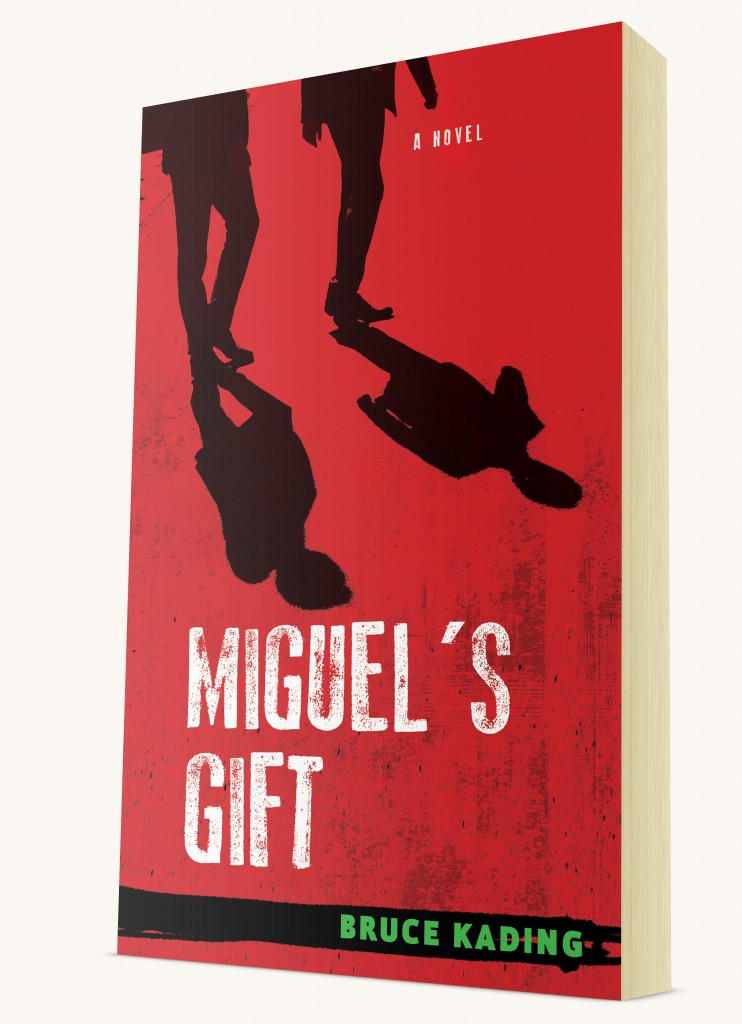 Miguel’s Gift details the rise of rookie immigration officer Nick Hayden, who must find an informant to access the inner circle of the counterfeit document ring run by crime kingpin Salvador Rico. A humble Mexican illegal immigrant, Miguel Chavez, agrees to the task in exchange for his family’s safety. As an unexpected friendship develops between Nick and Miguel—and as Nick confronts a secret that has haunted him since childhood—he is forced to contend with a part of himself he’d lost in the rough-and-tumble pursuit of his mission. As their investigation reaches a deadly climax, Nick must reassess what he thought he knew about courage, justice and loyalty.
Miguel’s Gift details the rise of rookie immigration officer Nick Hayden, who must find an informant to access the inner circle of the counterfeit document ring run by crime kingpin Salvador Rico. A humble Mexican illegal immigrant, Miguel Chavez, agrees to the task in exchange for his family’s safety. As an unexpected friendship develops between Nick and Miguel—and as Nick confronts a secret that has haunted him since childhood—he is forced to contend with a part of himself he’d lost in the rough-and-tumble pursuit of his mission. As their investigation reaches a deadly climax, Nick must reassess what he thought he knew about courage, justice and loyalty.
Bruce Kading has been employed by the INS, EPA and FBI. Informed by the author’s 26 years as an agent with the federal government, this gripping drama takes a nuanced perspective on illegal immigration. He talked to us about keeping his fiction true to life, and about taking an evenhanded approach to an issue that’s divided the nation.
What books are on your nightstand right now?
I’m reading Saturday by Ian McEwan, and a nonfiction book, A First-Rate Madness, by Nassir Ghaemi. I also recently finished several novels by Philip Roth, including Everyman and The Humbling, which deal with the emotional challenges of losing abilities that had given the main characters their reason for being. I am more interested in reading about psychological challenges and how people deal with them than with physical threats, though often the two go hand in hand.
Which character in your book would you say you’re most similar to, and why?
Certainly the main character, Nick Hayden, is in some ways similar to me, though the events depicted in the book, while informed by my experiences, did not actually happen to me. I did start my career with INS in Chicago; I was on the street arresting large numbers of people even before receiving formal training, and I did experience the daily rough-and-tumble that almost all agents went through during a rather unique period of immigration enforcement. I also worked many counterfeit document cases, developed informants, and did a fair amount of undercover work. Like Hayden, I was driven to perform well and took the work very seriously, though the historical baggage that motivates Hayden was not present in my life.
When you were working as a federal agent, did you know you would want to write about your experiences on the job?
Toward the end of my career I began to think about it, but after leaving the government I spent several years doing other types of writing before I could approach the subject more objectively. I considered nonfiction options but at some point realized that fiction has the advantage of flexibility in telling a story with a dramatic arc while conveying a sense of things as they were.
As a federal agent turned author, what are the keys to accurately representing an officer in a fictional crime procedural?
This can be difficult because the demands of the story can collide with what might realistically happen to a law enforcement agent. I had to continually ask myself whether various events, though they had not actually happened to me, could have happened. If I was satisfied that based on my 26 years of experience as an agent these things could have happened, I was comfortable using them to advance the story line. You have to guard against the temptation to let things happen simply to make it a more interesting story, because you can lose a sense of authenticity.
The topic of illegal immigration is very relevant to today’s politics and our current administration. What books would you recommend to better understand the issues surrounding illegal immigration, and why?
The Shadow Catcher by Hipolito Acosta is a factual account of his experiences over three decades as an INS agent. Acosta grew up in a poor, rural area near the border with Mexico and rose to a high position with INS. Aside from being an inspiring personal story, the book gives the reader a sense of how an ever fluctuating immigration policy has sent conflicting messages to those who risk everything to live and work in the United States. Acosta was involved in high-level criminal investigations, many of them targeting organizations that profited from smuggling immigrants into the country, but he never lost a strong sense of empathy for those immigrants who sought only to work in the United States and provide for their families.
Immigration Chaos by Neville Cramer is another book written by a former INS agent and high-ranking official that offers a superb inside look at the politics that have dominated and hamstrung efforts to bring order to the nation’s immigration policy. In particular, Cramer argues persuasively that one of the keys to a rational immigration policy is establishing a mandatory verification system so those who apply for jobs establish their legal right to work in the United States through authenticated documentation. Though Cramer was often frustrated in his efforts to make immigration enforcement more coherent and effective from inside the bureaucracy, his book is a compelling and valuable addition to the historical record.
What do you think are the biggest misconceptions surrounding immigration and immigration enforcement?
The ongoing political debate seems to have encouraged a somewhat distorted view of immigrants from both sides of the political spectrum. There is perhaps an overemphasis by the conservative right to cast illegal immigrants as being more inclined to criminal behavior than the average citizen, and an equally unrealistic view from some on the political left that almost any enforcement of immigration laws is wrong and that we should have virtually open borders. Simplistic solutions such as building a wall along the border with Mexico do not address the underlying problem, which is that illegal immigration will continue as long as people can obtain employment in the United States without presenting valid documents. At least 40 percent of undocumented immigrants come into the country as visitors or students, so a wall would not address that issue. Cutting off the employment incentive would go a long way toward dealing with it. In the meantime, a realistic and humane way of dealing with the millions of undocumented immigrants already here should be part of the solution.
 What do you hope readers take away from this novel?
What do you hope readers take away from this novel?
I would hope that readers will be less inclined to embrace misconceptions about immigration and undocumented immigrants. By presenting characters such as Miguel, perhaps some readers will take a more nuanced view of illegal immigrants in general, seeing them as the multidimensional human beings they are. Hopefully, the book helps break down some of the stereotypes of immigrants by presenting the good along with the bad.
I also hope readers will take away a better understanding of and appreciation for this unique and relatively unpublicized niche within the law enforcement community.
Miguel’s Gift arrived on shelves on April 1, 2017 and is available wherever books and e-books are sold.
No Comments
No comments yet.